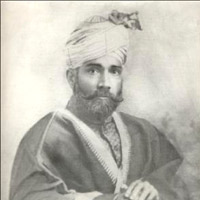The Shahidganj mosque, located in Landa bazaar outside Delhi gate at Lahore, was considered as the holy place for both Muslims and Sikhs. It was occupied by Sikhs in the eighteenth century and was used as a Sikh gurdwara for almost 170 years. Though through out that period Muslims were not allowed to offer prayers in the mosque, yet the building was physically kept intact.
The Muslims kept on protesting against the Sikh occupation of the Mosque for a long time. However, the situation got out of control when, suddenly on 29 June 1935, the Sikh community announced to demolish the Mosque. On the same night, a Muslim crowd of three or four thousand assembled in front of the mosque to protect it. A direct fight between this crowd and the Sikhs inside the gurdwara was averted by the intervention of the government authorities. Later, the British took an undertaking from the Sikhs that they would not further demolish the mosque. But, during the next week, while strenuous efforts were being made to persuade the leaders to reach an amicable settlement, the Sikh leaders, under pressure from the extremist element, again set out to demolish the mosque.
In the beginning, the Muslim leaders reacted in a mild way. Anjuman-i-Tahaffuz-i-Masjid Shahidganj (a committee for the protection of the Shahidganj mosque) was founded by a wide spectrum of Unionist Muslims, lawyers, journalists and biradari leaders to find legal means to protect the mosque and press for peaceful settlement of the issue. However, leaders like Maulana Zafar Ali Khan warned that the issue could lead to a great bloodshed if the matter was not settled immediately for the Muslims would not hesitate to make any sacrifice to preserve the mosque.
Appreciating the importance of the issue, Sir Herbert Emerson, the Governor of the Punjab, encouraged a negotiated
settlement. But, on the night of July 7, the Sikhs demolished the mosque. The news spread like wild fire throughout Lahore, but, before any serious reaction, curfew was enforced in the city and the situation was controlled. When the curfew was lifted, the Muslims, under Maulana Zafar Ali Khan, formed the Majlis Ittehad-i-Millat on July 14, with an object to fight for the mosque. They even planned to recruit volunteers, dressed them in blue shirts, for the purpose of carrying on the agitation. The fact of the matter was that behind the Shahidganj agitation lay the impulse of Lahore’s Muslims to assert the moral sovereignty of the Muslim community of which the mosque itself was a symbol and of which the principle of the supremacy of the Shariat was more than a symbol.
The Muslims held a public meeting on July 19 at the Badshahi mosque, after Friday prayers. The speakers urged the worshippers to march directly on the Shahidganj mosque. Inspired with the religious zeal and shouting religious slogans, the Muslims gathered at the entrance to Landa bazaar in front of the city police station. They did not want to listen to the police. They were ready to die in the way of their mission. When police failed to get control of the situation, and unable to disperse processionist peacefully, they, twice, opened fire on the crowd on July 20. The Muslims finally dispersed when more than a dozen of them died due to heavy firing by the police on the evening of July 21. The situation in Lahore continued to cause anxiety till the close of the year.
This article was last updated on Monday, Jan 01, 2007






